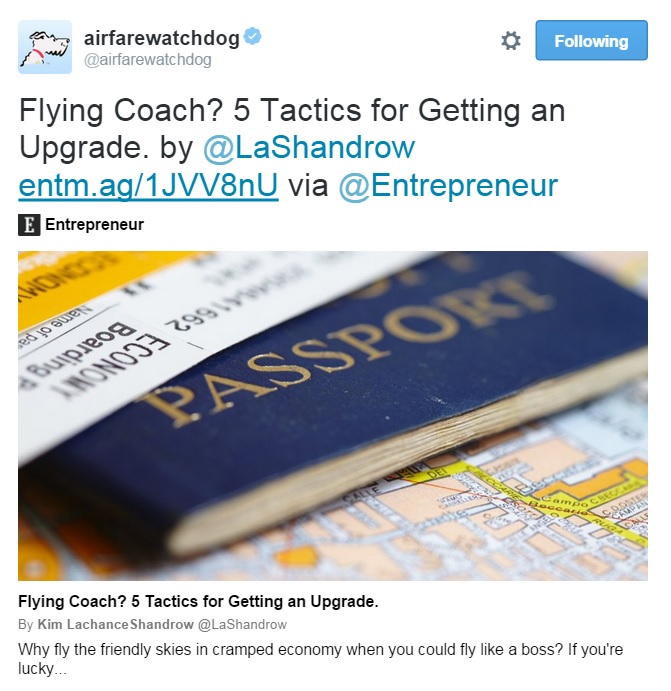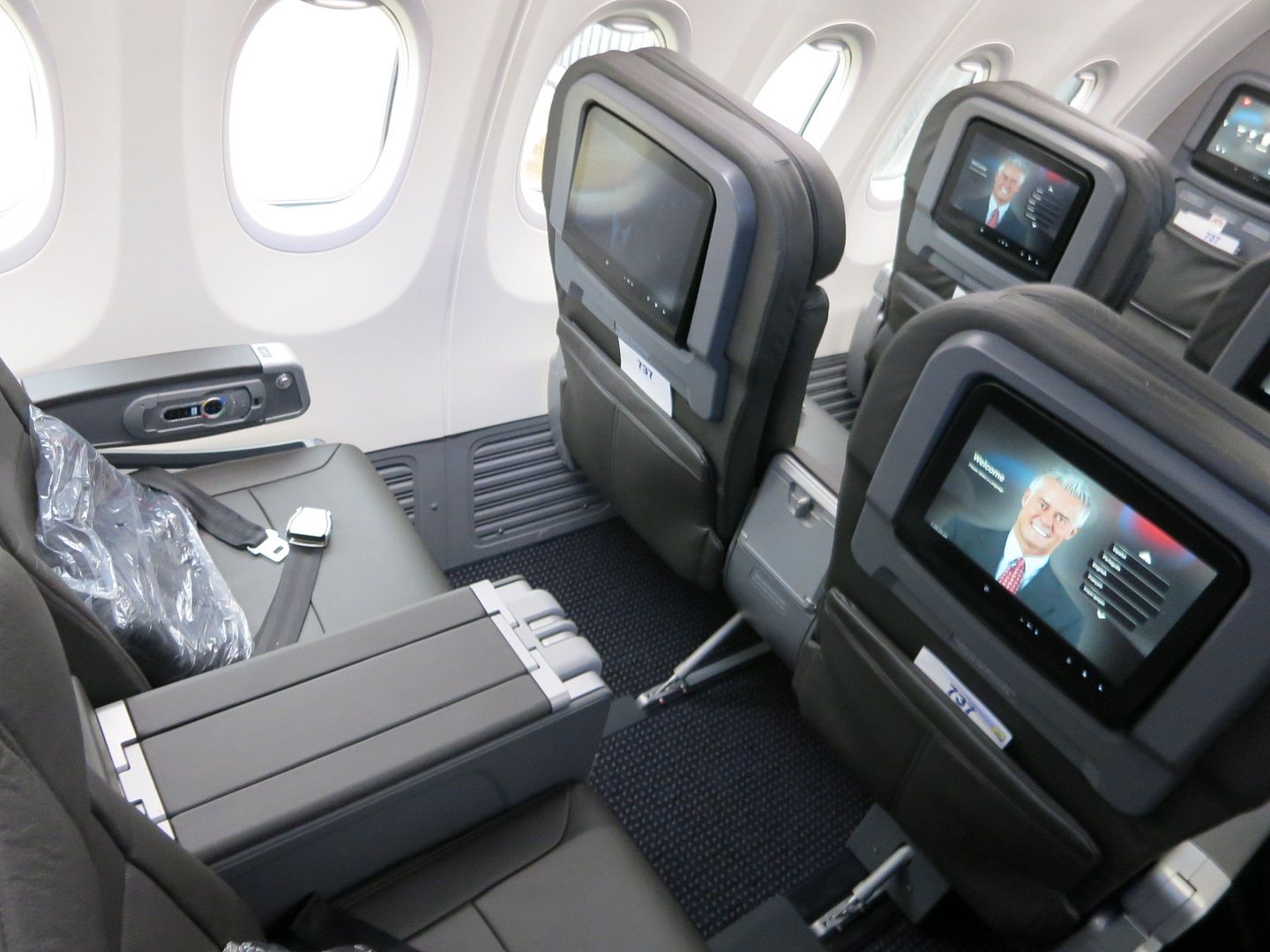Airline upgrades are almost exclusively done by formula, with little discretion allowed to gate or check-in counter agents.
The only time there may be wiggle room is when a flight is oversold, and while elite frequent flyers may get preference for moving up to a premium cabin, the most important priority is getting a flight out on time. Other than these “operational upgrades” though, upgrades are going to be based on published criteria – not who is nicest, who dresses best, or who asks.
@mpaleytravel points me to this:

And I wanted to bang my head against the wall. I wish we could put this genre of mainstream media article about upgrades to rest, for good.
- “Ask and ye might receive” .. I don’t believe this story, while I don’t doubt it has happened flight attendants could get fired for it:
“I went up to the flight attendant, turned up my charm and asked, ‘What would it take for me to ride up where I belong?’ She chuckled, and gave me a seat.”
- “Go global” flying a foreign airline may get you a better shot of an upgrade because they don’t care about profits. In general many non-US airlines go to greater lengths to guard the exclusivity of their forward cabins. Upgrades aren’t as common in many markets outside the US as they are here. (On the other hand, empty premium cabin seats generally aren’t taken up by employees, either.)
- “Dress the part” George Hobica says that for operational upgrades “they’re going to choose the person who’s well-dressed over the one who isn’t.” This is a very limiting case, and I’d rather rely on ‘The Speech’ than dapper menswear.
- “Score a last minute deal” no question there can be buy ups offered at checkin that are less expensive than paying full freight, but that’s a risky proposition that it’ll be offered and often still expensive.
- “Raise a fuss” — perhaps the worst idea of the lot, you’re just as likely to wind up in Guantanamo as in a first class seat.
I’m willing to bet not a single person gets upgraded as a result of having read the article.
You don’t have to be a 100,000 mile flyer to get a first class upgrade on domestic flights — even most of the time — provide you have a little bit of flexibility or are willing to spend some miles and money (but a whole lot less than actually buying the full first class fare).
So here are five less exciting, but more realistic, strategies for sitting up front.

- Jump Ahead of All the Elites By Confirming Your First Class Upgrade With Miles. Several airlines, like United and American, let you upgrade domestically with miles on any paid fare. If you have elite status with United (25,000 mile status or higher) you can spend miles and they will waive the cash co-pay that’s charged in addition to miles.
General members of United’s MileagePlus, and all members of American AAdvantage, have to pay the cash co-pay when redeeming miles for the upgrade. United’s price is variable based on your fare, American’s is fixed (except for full fare tickets).
American will charge you $75 plus 15,000 miles to upgrade in one direction on a domestic ticket. So the miles from a credit card signup are enough for three one-way upgrades or more.
- Book an Award Ticket. For short flights under 650 miles, it can cost as little as 9000 British Airways points each way for business class on American (think New York – Toronto) which comes with priority boarding and free checked bags. A domestic roundtrip on Alaska Airlines runs 40,000 Korean Air points, transferred in from Chase or Starwood.
- Just Buy the First Class Seat… at a Discount Airlines used to charge full fare for first class only, and didn’t discount. They sold fewer seats that way, and had more left over for upgrades. Now they frequently sell the seats at a discount, and it’s worth looking to see what the price of first class is when shopping for flights.
If you were going to spend miles and cash to upgrade, it may be ‘cheaper’ to just buy the ticket. For instance on shorter flights I’ll often see American price first class at ~ $120 more than coach. I’d rather spend $120 than spend $75 plus 15,000 miles (because in that case the miles would only get me 3/10ths of a cent in savings). Of course I’d usually rather hold out for a complimentary upgrade, and will often settle for extra legroom seats if my upgrade doesn’t clear.
- Avoid Your First Class Upgrade Competition. If you’re eligible for a complimentary upgrade or to be bumped up to first class with e-upgrade stickers, you want to maximize your chances. A 100,000 mile flyer will usually get their upgrade, a 25,000 mile flyer won’t… but the tables can be turned by picking and choosing your flight times.
Business travelers fly the most and have the highest status, usually. So flights that are popular for business travel have the most elite frequent flyer competition for upgrades.
That means you want to avoid flying when business travelers fly. Monday mornings and Thursday and Friday evenings can be toughest. There’s a not insignificant number of business travelers starting their weeks on Sunday nights, too.
- Fly mid-day
- Fly mid-week, or Saturday
The noon flight on Tuesday, Wednesday, or Saturday won’t encounter many business travelers, and thus won’t encounter many elites fighting you for your upgrade.
- Fly mid-day
- Pick Flights on Planes That Maximize Your Chances of the First Class Upgrade. More first class seats mean more upgrades, so pick the planes that have the most seats — or, more specifically, have the greatest percentage of premium seats.
You may not be in the top 6% of elites looking for a first class upgrade on a flight, but you might be in the top 12%. A cabin with 12% premium seats gives you a much better shot at the upgrade.
Three years ago I recorded a video on how to get airline upgrades. Most of the advice still rings true.


As a corollary to #3, though, it would be helpful if you could add some explanation of how a consumer can know when they are actually buying real discounted F, and not some oddball fare class with an “automatic upgrade” that disappears into thin air when IRROPS occurs. Have heard a lot of convoluted, conflicting, and frankly downright weird stories relating to this topic.
Yet again- accurate, common sense, useful travel advice from you, vs. crazy, flat-out stupid advice so commonly promoted by the media. Sometimes I’m selfishly grateful there is so much terrible
advice out there because it leaves more options for savvy travelers.
Gary, AA Domestic F tickets are 18,000 miles. Your use of New York – YYZ is highly misleading
@jeo – But transborder flights book into business class so under 650 miles = 9000 points. My math is right in the post for the route example I gave.
I always just tell them I’m Gary Leff, traveling incognito. Works about half the time.
That article might as well have advised you to ride into the airport on a hoverboard to impress the gate agent.
On the non-travel blogs and forums I read, whenever the subject of travel comes up there are always a few people who claim that they got upgrades to business or first just by asking/ dressing nicely/ because they were on their honeymoon/ insert random reason. I usually assume most of them are lying, because it seems like airline status holders watch those upgrade lists like hawks and will happily scream shenanigans if necessary. Or at least it does based on posts I see on FT and other travel forums and blogs.
I’ve held Senator (Gold) status with Lufthansa for long enough for them to award me a “star” on my card, however, LH rarely upgrade me. I’ve had more luck with Swiss, but only on short European flights. 15 years ago, I held Gold with BA, and frequently achieved an upgrade. I also held Platinum with Air France/ KLM (Skyteam) for 8 years, and rarely got upgraded. Its a European thing. The airlines love to maintain their class differential, and will only upgrade if overbooked and there is no alternative.
CW,
ah, delta’s (in)famous “A” fares. the only way to know the deceitful trick of these fares, besides reading about them on flyertalk and its ilk, is to find out the hard way.
It’s so easy for media outlets to generate (“regurgitate” would be more appropriate) these stories. It requires zero thought, just repeat the same myths that everyone has heard countless times, and pretty much guaranteed to generate lots of clicks. I’m with Gary — I wish we could obliterate such nonsense.
@ctj – Actually, I was talking about AA/US! I’m not a DL guy. But – sounds like this really is something that could use a bit of attention given to it!!!
Adding to your point#4 in avoiding elites. Another tip is that your are more likely to score an upgrade as a lower elite class on non-elite heavy routes. For example DFW-HKG or DFW-ORD you might be out of luck with AA while some other minor routes you might find very few elites and maybe even more open F seats although you might be on a smaller plane.